Abstract
Respiratory symptoms and lung function were assessed in 41 seasonal grain handlers and related to duration of employment and level of exposure to grain dust. Ten public works department employees, not exposed to grain dust, were examined during the same period. Respiratory symptoms, forced expired volume in one second (FEV1), and bronchial responsiveness (dose of methacholine provoking a 20% fall in FEV1-PD20) were assessed before starting work and at weekly intervals during a period of employment lasting up to four weeks. Two atopic grainhandlers with pronounced bronchial hyperresponsiveness (PD20 less than 1 mumol) and a history of asthma withdrew from the study within two weeks because they developed severe asthma. Respiratory symptoms were more frequent and more often attributed to work in the grainhandlers than in the non-exposed subjects. In the grainhandlers the FEV1 decreased by a mean (95% confidence intervals) of 321 ml (198-444) (p less than 0.05) and the mean (95% confidence interval) PD20 decreased from 20.6 mumol (10.3-41.2) to 6.0 mumol (2.8-12.5) (p less than 0.05) after one week of work. Over the next three weeks the mean FEV1 returned towards the prestudy values. The mean PD20, however, remained significantly lower than the initial value. The mean FEV1 and PD20 did not change significantly in the non-exposed subjects. The frequency of symptoms and decreases in FEV1 were greater in grainhandlers when working in jobs where total exposure to dust was greater than 20 mg/m3 than when working in jobs where it was less than 10 mg/m3. The results indicate that occupational exposure to grain dust results in respiratory symptoms and changes in lung function, including increased airway responsiveness, within the first week of exposure to grain dust at work. These changes appear to be determined by the degree of dust exposure and suggest a direct effect of grain dust on the lung in these subjects.
Full text
PDF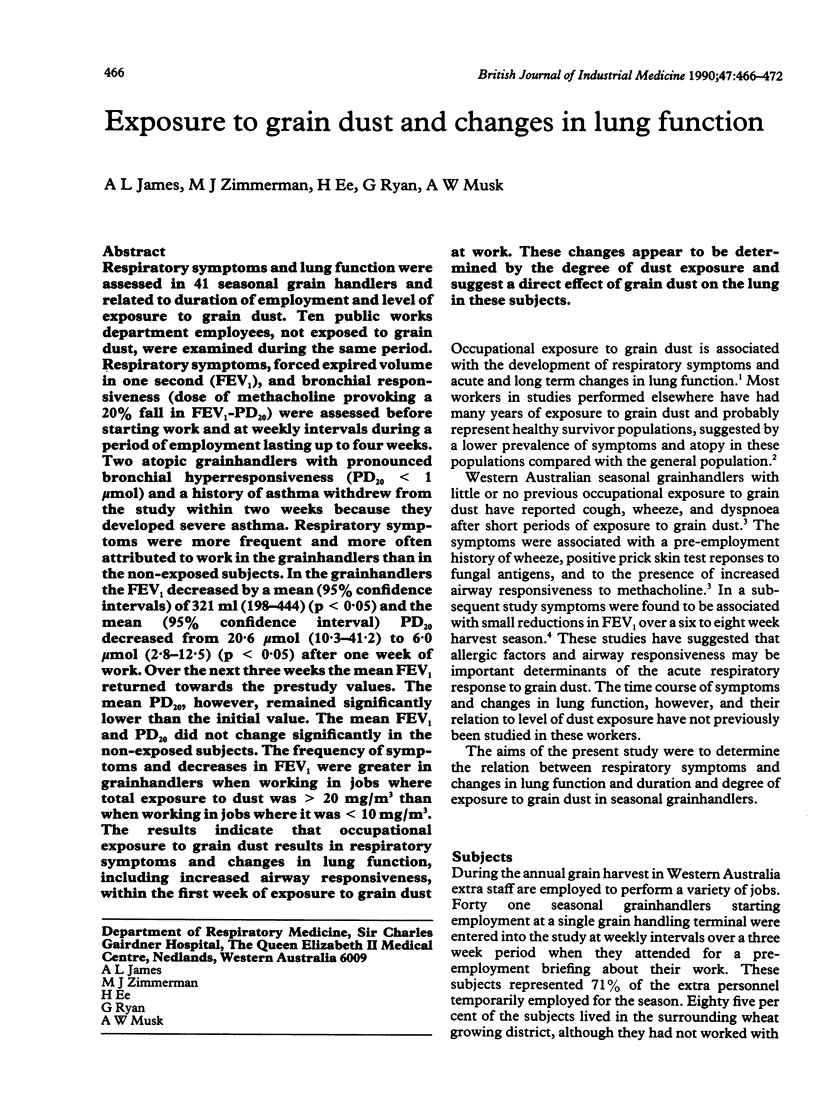
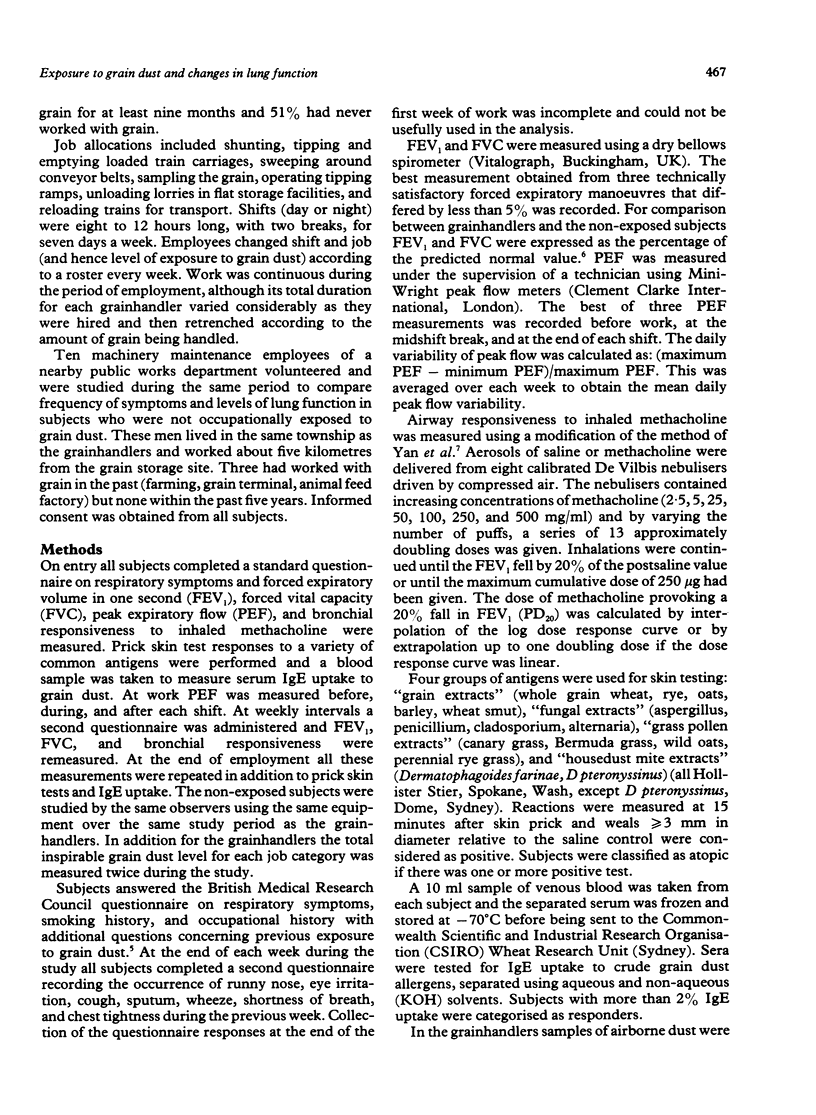
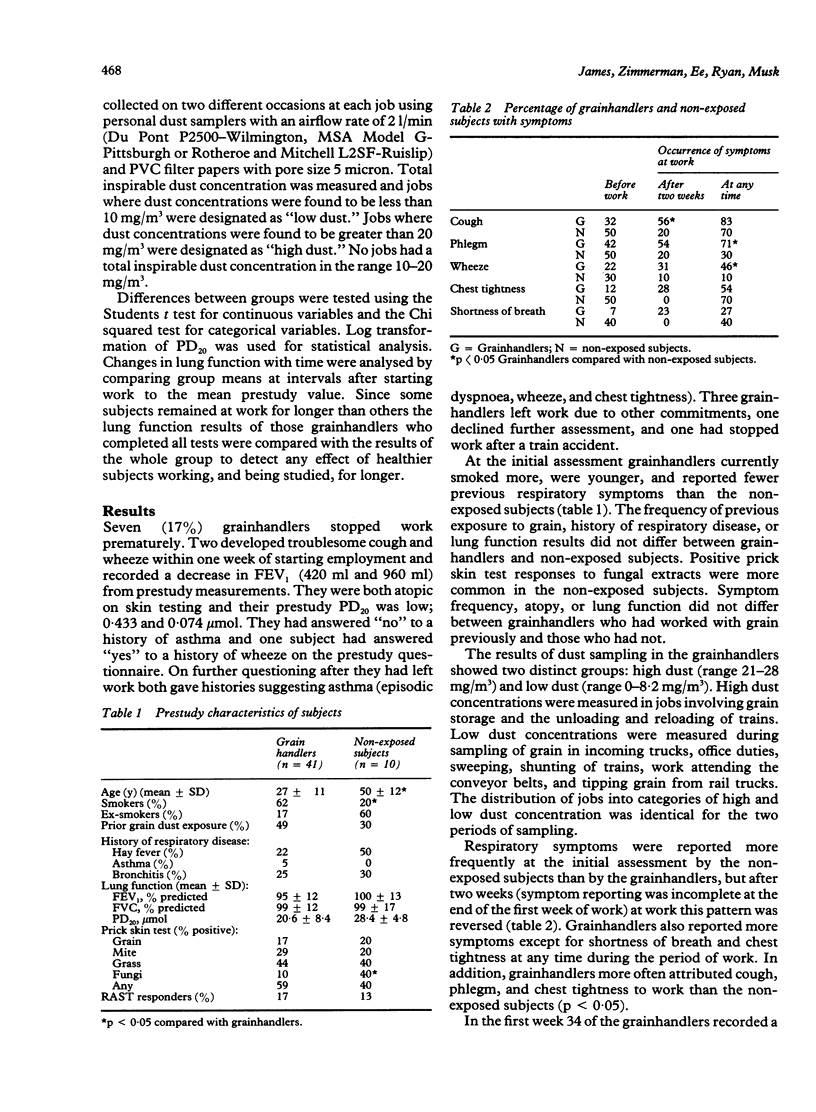
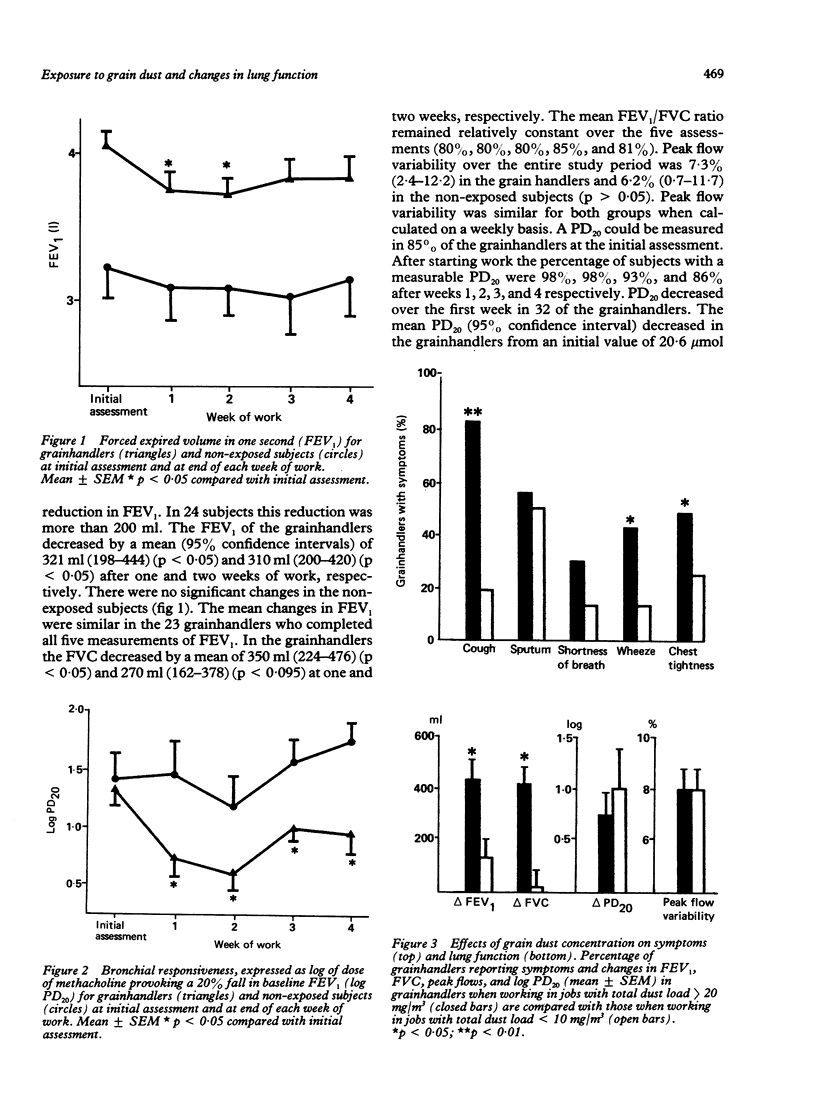
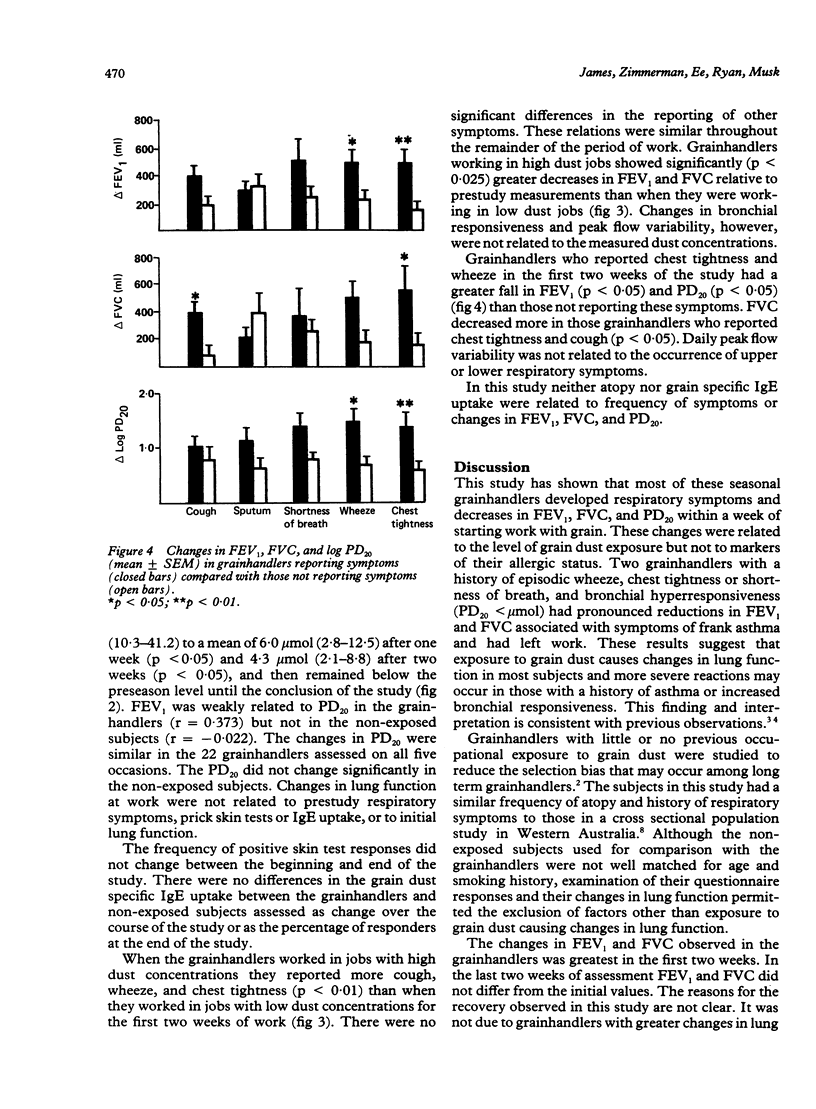
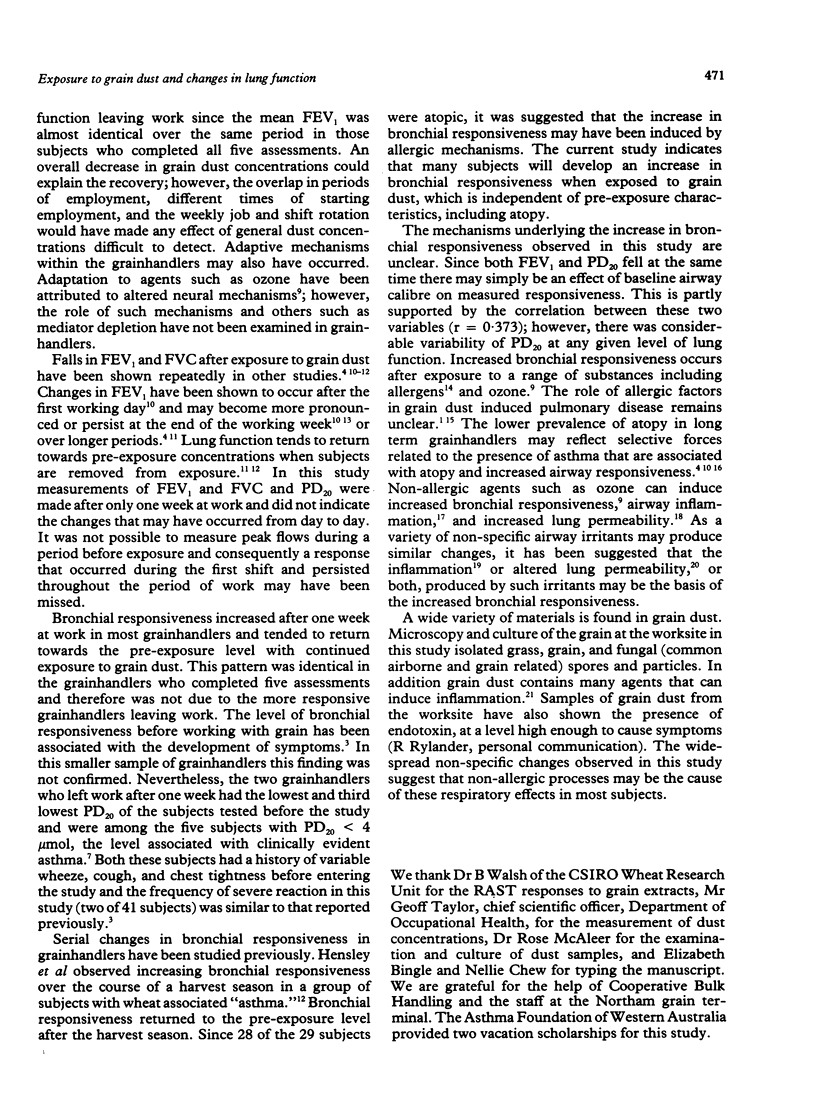
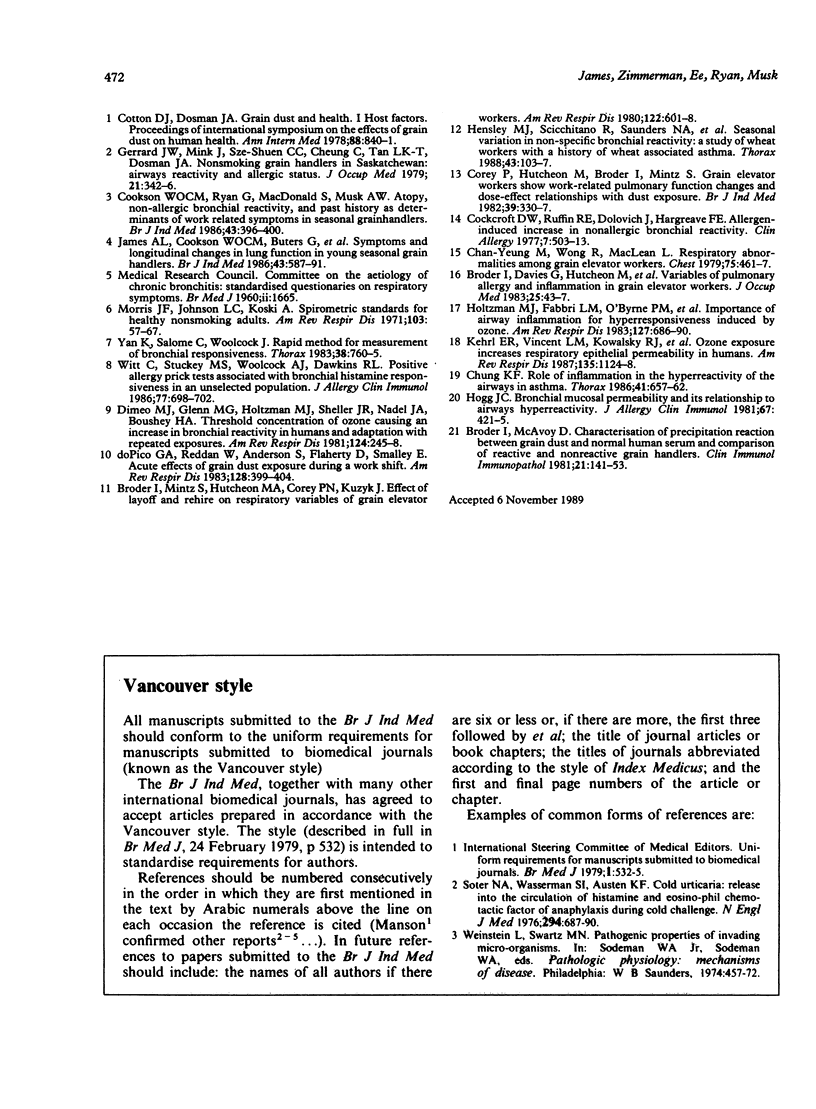
Selected References
These references are in PubMed. This may not be the complete list of references from this article.
- Broder I., Davies G., Hutcheon M., Leznoff A., Mintz S., Thomas P., Corey P. Variables of pulmonary allergy and inflammation in grain elevator workers. J Occup Med. 1983 Jan;25(1):43–47. doi: 10.1097/00043764-198301000-00014. [DOI] [PubMed] [Google Scholar]
- Broder I., McAvoy D. Characterization of precipitation reaction between grain dust and normal human serum and comparison of reactive and nonreactive grain handlers. Clin Immunol Immunopathol. 1981 Nov;21(2):141–153. doi: 10.1016/0090-1229(81)90203-8. [DOI] [PubMed] [Google Scholar]
- Broder I., Mintz S., Hutcheon M. A., Corey P. N., Kuzyk J. Effect of layoff and rehire on respiratory variables of grain elevator workers. Am Rev Respir Dis. 1980 Oct;122(4):601–608. doi: 10.1164/arrd.1980.122.4.601. [DOI] [PubMed] [Google Scholar]
- Chan-Yeung M., Wong R., MacLean L. Respiratory abnormalities among grain elevator workers. Chest. 1979 Apr;75(4):461–467. doi: 10.1378/chest.75.4.461. [DOI] [PubMed] [Google Scholar]
- Chung K. F. Role of inflammation in the hyperreactivity of the airways in asthma. Thorax. 1986 Sep;41(9):657–662. doi: 10.1136/thx.41.9.657. [DOI] [PMC free article] [PubMed] [Google Scholar]
- Cockcroft D. W., Ruffin R. E., Dolovich J., Hargreave F. E. Allergen-induced increase in non-allergic bronchial reactivity. Clin Allergy. 1977 Nov;7(6):503–513. doi: 10.1111/j.1365-2222.1977.tb01481.x. [DOI] [PubMed] [Google Scholar]
- Cookson W. O., Ryan G., MacDonald S., Musk A. W. Atopy, non-allergic bronchial reactivity, and past history as determinants of work related symptoms in seasonal grain handlers. Br J Ind Med. 1986 Jun;43(6):396–400. doi: 10.1136/oem.43.6.396. [DOI] [PMC free article] [PubMed] [Google Scholar]
- Corey P., Hutcheon M., Broder I., Mintz S. Grain elevator workers show work-related pulmonary function changes and dose-effect relationships with dust exposure. Br J Ind Med. 1982 Nov;39(4):330–337. doi: 10.1136/oem.39.4.330. [DOI] [PMC free article] [PubMed] [Google Scholar]
- Dimeo M. J., Glenn M. G., Holtzman M. J., Sheller J. R., Nadel J. A., Boushey H. A. Threshold concentration of ozone causing an increase in bronchial reactivity in humans and adaptation with repeated exposures. Am Rev Respir Dis. 1981 Sep;124(3):245–248. doi: 10.1164/arrd.1981.124.3.245. [DOI] [PubMed] [Google Scholar]
- Gerrard J. W., Mink J., Cheung S. S., Tan L. K., Dosman J. A. Nonsmoking grain handlers in Saskatchewan: airways reactivity and allergic status. J Occup Med. 1979 May;21(5):342–346. [PubMed] [Google Scholar]
- Hensley M. J., Scicchitano R., Saunders N. A., Cripps A. W., Ruhno J., Sutherland D., Clancy R. L. Seasonal variation in non-specific bronchial reactivity: a study of wheat workers with a history of wheat associated asthma. Thorax. 1988 Feb;43(2):103–107. doi: 10.1136/thx.43.2.103. [DOI] [PMC free article] [PubMed] [Google Scholar]
- Hogg J. C. Bronchial mucosal permeability and its relationship to airways hyperreactivity. J Allergy Clin Immunol. 1981 Jun;67(6):421–425. doi: 10.1016/0091-6749(81)90094-4. [DOI] [PubMed] [Google Scholar]
- Holtzman M. J., Fabbri L. M., O'Byrne P. M., Gold B. D., Aizawa H., Walters E. H., Alpert S. E., Nadel J. A. Importance of airway inflammation for hyperresponsiveness induced by ozone. Am Rev Respir Dis. 1983 Jun;127(6):686–690. doi: 10.1164/arrd.1983.127.6.686. [DOI] [PubMed] [Google Scholar]
- James A. L., Cookson W. O., Buters G., Lewis S., Ryan G., Hockey R., Musk A. W. Symptoms and longitudinal changes in lung function in young seasonal grain handlers. Br J Ind Med. 1986 Sep;43(9):587–591. doi: 10.1136/oem.43.9.587. [DOI] [PMC free article] [PubMed] [Google Scholar]
- Kehrl H. R., Vincent L. M., Kowalsky R. J., Horstman D. H., O'Neil J. J., McCartney W. H., Bromberg P. A. Ozone exposure increases respiratory epithelial permeability in humans. Am Rev Respir Dis. 1987 May;135(5):1124–1128. doi: 10.1164/arrd.1987.135.5.1124. [DOI] [PubMed] [Google Scholar]
- Morris J. F., Koski A., Johnson L. C. Spirometric standards for healthy nonsmoking adults. Am Rev Respir Dis. 1971 Jan;103(1):57–67. doi: 10.1164/arrd.1971.103.1.57. [DOI] [PubMed] [Google Scholar]
- Witt C., Stuckey M. S., Woolcock A. J., Dawkins R. L. Positive allergy prick tests associated with bronchial histamine responsiveness in an unselected population. J Allergy Clin Immunol. 1986 May;77(5):698–702. doi: 10.1016/0091-6749(86)90413-6. [DOI] [PubMed] [Google Scholar]
- Yan K., Salome C., Woolcock A. J. Rapid method for measurement of bronchial responsiveness. Thorax. 1983 Oct;38(10):760–765. doi: 10.1136/thx.38.10.760. [DOI] [PMC free article] [PubMed] [Google Scholar]
- doPico G. A., Reddan W., Anderson S., Flaherty D., Smalley E. Acute effects of grain dust exposure during a work shift. Am Rev Respir Dis. 1983 Sep;128(3):399–404. doi: 10.1164/arrd.1983.128.3.399. [DOI] [PubMed] [Google Scholar]


